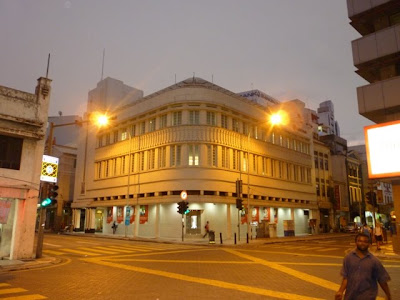
When the admittedly popular Popular Bookstore was relocated from the heart of Petaling Street to the corner of Jalan Hang Lekir and Jalan Tun H.S. Lee, I was pleased with how accessible it is now from the Pasar Seni LRT station. As soon as I saw the building it is currently housed in, I had another reason to rejoice. The Bangunan Lee Rubber is one of the finest examples of Art Deco architecture I have ever seen.

The discrete horizontal 'banding' on the exterior facade and the spandrels in Fauvist colours are the first indications that this is an Art Deco building. Like most urban Deco buildings, the Bangunan Lee Rubber has a flat roof with no cornice or overhang.


The narrow windows, considering the full surface of the walls, are characteristic of Art Deco buildings of that era. Repeated geometric patterns below the windows create a sense of theatric opulence. The windows above the Deco accents are of metal muntins, also in the Deco style.


Art Deco spandrels accentuate the space between the top of the window in one storey and the sill of the window in the storey above. Fluted pilasters halfway up the wall hold up an entablature with fluted rectangular motifs.
The construction of Bangunan Lee Rubber was commissioned in the early 1930s by the Lee Rubber Company, a multi-million dollar enterprise set up by Southeast Asia's rubber and pineapple king, Lee Kong Chian.
The building itself has a colourful history. It was once the headquarters of the Kempeitai (Japanese Secret Police) in Kuala Lumpur, according to the ‘Letters & Comment’ column in Asiaweek (15 September 1995) and the testimonies of various Malaysians who lived through World War II.
Later, the building became one of the branches of the Oversea-Chinese Banking Corporation (OCBC), which isn't surprising considering that Lee Kong Chian was once the general manager and vice-chairman of Huayi Bank, and was later appointed vice-chairman of OCBC when three Chinese banks merged to form the Oversea-Chinese Banking Corporation during the Great Depression in 1933.
"Jalan Tun H.S. Lee" was formerly known as "High Street", while "Jalan Hang Lekir" was formerly known as "Cecil Street" before the nationalisation of street names in Kuala Lumpur. Many of the double-storey shophouses along Jalan Tun H.S. Lee date back to the 1880s.
Tun H.S. Lee, or Tun Sir Henry Lee Hau-Shik (1900 - 1988) played a major role in helping to establish the Malayan Chinese Association (MCA) in 1949 and in initiating the coalition between MCA and UMNO in 1952, which led the then Malaya to Independence in 1957, so it is only proper and fitting that such an important and busy street be named after him.
Hang Lekir, on the other hand, was a warrior who lived during the height of the Malaccan Sultanate in the 15th century. Some of the street names in Kuala Lumpur have been named after warriors from the Malay Annals.

High Street leading to Foch Avenue (1930s). Photo reproduced from "Malaysia: A Pictorial History 1400 - 2004" by Wendy Khadijah Moore, without permission but in accordance with the principles of fair use.
The Bangunan Lee Rubber is a perfect example of how a coat of paint and a culture of maintenance can make a world of difference to heritage buildings. Heritage buildings in Kuala Lumpur do not have to be converted into unproductive galleries and deserted museums. They could still be utilised for commerce and trade and be wholly tenantable, as long as the property owners take pains to keep the building in good repair.
I wish that someday I could walk down the streets of Medan Pasar, Leboh Pudu and Jalan Tuanku Abdul Rahman and see that the Art Deco and Art Noveau buildings are as well-kept, clean and aesthetically pleasing as the Bangunan Lee Rubber.













































